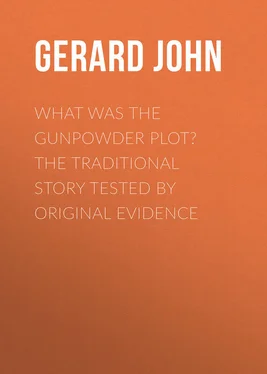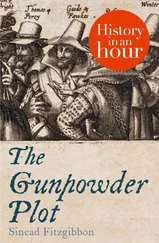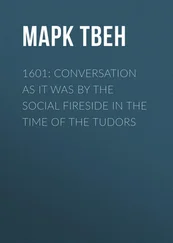John Gerard - What was the Gunpowder Plot? The Traditional Story Tested by Original Evidence
Здесь есть возможность читать онлайн «John Gerard - What was the Gunpowder Plot? The Traditional Story Tested by Original Evidence» — ознакомительный отрывок электронной книги совершенно бесплатно, а после прочтения отрывка купить полную версию. В некоторых случаях можно слушать аудио, скачать через торрент в формате fb2 и присутствует краткое содержание. Жанр: foreign_antique, foreign_prose, на английском языке. Описание произведения, (предисловие) а так же отзывы посетителей доступны на портале библиотеки ЛибКат.
- Название:What was the Gunpowder Plot? The Traditional Story Tested by Original Evidence
- Автор:
- Жанр:
- Год:неизвестен
- ISBN:нет данных
- Рейтинг книги:5 / 5. Голосов: 1
-
Избранное:Добавить в избранное
- Отзывы:
-
Ваша оценка:
- 100
- 1
- 2
- 3
- 4
- 5
What was the Gunpowder Plot? The Traditional Story Tested by Original Evidence: краткое содержание, описание и аннотация
Предлагаем к чтению аннотацию, описание, краткое содержание или предисловие (зависит от того, что написал сам автор книги «What was the Gunpowder Plot? The Traditional Story Tested by Original Evidence»). Если вы не нашли необходимую информацию о книге — напишите в комментариях, мы постараемся отыскать её.
What was the Gunpowder Plot? The Traditional Story Tested by Original Evidence — читать онлайн ознакомительный отрывок
Ниже представлен текст книги, разбитый по страницам. Система сохранения места последней прочитанной страницы, позволяет с удобством читать онлайн бесплатно книгу «What was the Gunpowder Plot? The Traditional Story Tested by Original Evidence», без необходимости каждый раз заново искать на чём Вы остановились. Поставьте закладку, и сможете в любой момент перейти на страницу, на которой закончили чтение.
Интервал:
Закладка:
The manner in which they came at last to discover the "cellar" is thus related by Mr. Jardine: 159 159 Gunpowder Plot , p. 55. This account is based almost entirely on that of Faukes, November 17th, 1605.
"One morning, while working upon the wall, they suddenly heard a rushing noise in a cellar, nearly above their heads. At first they imagined that they had been discovered; but Fawkes being despatched to reconnoitre, found that one Bright, to whom the cellar belonged, was selling off his coals 160 160 In his Italian version of Father Gerard's history, Father Greenway interpolates the following note: "Questi non erano carboni di legno, ma una sorte di pietra negra, la quale come carbone abrugia et fa un fuogo bellissimo et ottimo" (fol. 44 b).
in order to remove, and that the noise proceeded from this cause. Fawkes carefully surveyed the place, which proved to be a large vault, situated immediately below the House of Lords, and extremely convenient for the purpose they had in view… Finding that the cellar would shortly become vacant, the conspirators agreed that it should be hired in Percy's name, under the pretext that he wanted it for his own coals and wood. This was accordingly done, and immediate possession was obtained." 161 161 "These Pioneers through Piercies chamber brought Th' exhausted earth, great baskets full of clay; Thereby t' have made a mighty concave vau't, And of the house the ground worke tooke away: But then at last an obstacle they finde, Which to remove proud Piercy casts in 's mind. A thick stone wall their passage then did let; Whereby they cou'd not finish their intent. Then forthwith Piercy did a sellar get, Under that sacred house for yearly rent: Feigning to fill 't with Char coal, Wood, & Beere, From all suspect themselves to cloake & cleere." John Vicars, Mischeefes Mysterie This remarkable poem, published 1617, is a much expanded translation of Pietas Pontificia (in Latin hexameter verse) by Francis Herring, which appeared in 1606.
It is obvious that Mr. Bright's men must on this, as presumably upon many previous occasions, have been at work among the coals, while the miners were hammering at the foundations beneath them, and yet have been as little aware of what was going on as were the others of the existence of the "cellar." It must, farther, be noted that the hiring of this receptacle was, in fact, by no means so easy a matter as the accounts ordinarily given would lead us to suppose. Faukes, in the narrative on which the whole history of this episode has been based, is made to say that he found that the coals were a-selling, and the cellar was to be let, whereupon Percy went and hired it. Mrs. Whynniard, however, tells us that the cellar was not to let, and that Bright had not the disposal of the lease, but one Skinner, and that Percy "laboured very earnestly" before he succeeded in obtaining it.
But, whatever the circumstances and manner of the transaction, it appears that at Lady-day, 1605, this chamber came into the hands of those who were to make it so famous; whereupon, we are told, they resolved to abandon the mine, and use this ready-made cavity for their purposes. To it, accordingly, they transferred their powder, the barrels, by subsequent additions, being increased to thirty-six, and the amount to nine or ten thousand pounds. 162 162 On this point we are furnished with more than the usual amount of variety as to details. Cecil, writing to the ambassadors (Cornwallis, Edmondes, etc.), says there were "two hodgsheads and some 30 small barrels." The King's Discourse mentions 36 barrels. Barclay ( Conspiratio Anglicana ) says there were over 9,000 lb. of powder, in 32 barrels, and that one of extra size had been placed under the throne, for treason could not without dread assail Majesty even when unarmed. The indictment of the conspirators named 30 barrels and 4 hogsheads. Sir E. Coke always said 36 barrels. Barlow's Gunpowder Treason makes the extraordinary statement, frequently reproduced, that "to the 20 Barrels of Powder laid in at first, they added in July 20 more, and at last made up the number Thirty-six." Faukes (November 5th) said that of the powder "some was put in hoggesheads, some in Barrels, and some in firkins." Faukes also says that the powder was conveyed to the place in hampers. John Chamberlain, writing to Dudley Carleton, November 7th, 1605, says it was carried in satchels. Barlow ( ut sup. ) quotes the amount as 9,000 or 10,000 lb.
The casks were covered with firewood, 500 faggots and 3,000 billets being brought in by hired porters and piled up by Faukes, to whose charge, in his assumed character of Percy's servant, the cellar was committed. It is stated in Winter's long declaration on this subject, 163 163 November 23rd, 1605.
that the barrels were thus completely hidden, "because we might have the house free, to suffer anyone to enter that would," and we find it mentioned by various writers subsequently, that free ingress was actually allowed to the public. Thus we read 164 164 The Gunpowder Plot , by L., 1805. It seems highly probable that the "cellar" was used as a public passage.
of "the deep cunning [of the conspirators] in throwing open the vault, as if there had been nothing to conceal;" while another writer 165 165 Hugh F. Martyndale, A Familiar Analysis of the Calendar of the Church of England (November 5th). London, Effingham Wilson.
tells us, "The place was hired by Percy; 36 barrels of gunpowder were lodged in it; the whole covered up with billets and faggots; the doors of the cellar boldly flung open, and everybody admitted, as though it contained nothing dangerous." On the top of the barrels were likewise placed "great bars of iron and massy stones," in order "to make the breach the greater."
We may here pause to review the extraordinary story to which we have been listening. A group of men, known for as dangerous characters as any in England, men, in Cecil's own words, 166 166 Letter to Cornwallis and Edmondes , November 9th, 1605.
"spent in their fortunes," "hunger-starved for innovations," "turbulent spirits," and "fit for all alterations," take a house within the precincts of a royal palace, and close to the Upper House of Parliament, dig a mine, hammer away for over two months at the wall, acquire and bring in four tons of gunpowder, storing it in a large and conspicuous chamber immediately beneath that of the Peers, and covering it with an amount of fuel sufficient for a royal establishment – and meanwhile those responsible for the government of the country have not even the faintest suspicion of any possible danger. "Never," it is said, 167 167 H.F. Martyndale, ut sup.
"was treason more secret, or ruin more apparently inevitable," while the Secretary of State himself declared 168 168 Letter to the Ambassadors, ut sup.
that such ruin was averted only by the direct interposition of Heaven, in a manner nothing short of miraculous.
It must be remembered that the government thus credited with childlike and culpable simplicity, was probably the most suspicious and inquisitive that ever held power in this country, for its tenure whereof it trusted mainly to the elaborate efficiency of its intelligence department. Of a former secretary, Walsingham, Parsons wrote that he "spent infinite upon spyery," 169 169 An Advertisement written to a Secretarie , etc. (1592), p. 13.
and there can be no doubt that his successor, now in office, had studied his methods to good purpose. "He," according to a panegyrist, 170 170 Sir R. Naunton, Fragmenta Regalia (Harleian Miscellany , ii. 106).
"was his craft's master in foreign intelligence and for domestic affairs," who could tell at any moment what ships there were in every port of Spain, their burdens, their equipment, and their destination. We are told 171 171 Blount to Parsons (Stonyhurst MSS.), Anglia , vi. 64.
that he could discover the most secret business transacted in the Papal Court before it was known to the Catholics in England. He could intercept letters written from Paris to Brussels, or from Rome to Naples. 172 172 Such letters are found amongst the State Papers.
What was his activity at home is sufficiently evidenced by the reports furnished by his numerous agents concerning everything done throughout the country, in particular by Recusants; whereof we shall see more, in connection with this particular affair. That those so remarkably wide-awake in regard of all else should have been blind and deaf to what was passing at their own doors appears altogether incredible.
Интервал:
Закладка:
Похожие книги на «What was the Gunpowder Plot? The Traditional Story Tested by Original Evidence»
Представляем Вашему вниманию похожие книги на «What was the Gunpowder Plot? The Traditional Story Tested by Original Evidence» списком для выбора. Мы отобрали схожую по названию и смыслу литературу в надежде предоставить читателям больше вариантов отыскать новые, интересные, ещё непрочитанные произведения.
Обсуждение, отзывы о книге «What was the Gunpowder Plot? The Traditional Story Tested by Original Evidence» и просто собственные мнения читателей. Оставьте ваши комментарии, напишите, что Вы думаете о произведении, его смысле или главных героях. Укажите что конкретно понравилось, а что нет, и почему Вы так считаете.












